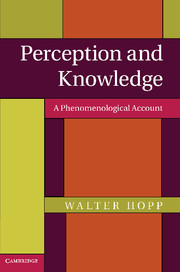Book contents
4 - Against experiential conceptualism
Published online by Cambridge University Press: 21 April 2011
Summary
In the last two chapters I have examined phenomenological and epistemological arguments for experiential conceptualism, and have argued that none of them is decisive, and have also presented a number of considerations that strongly speak against the theory. The task of this chapter is to argue that no version of EC can adequately capture either the phenomenological character of perceptual experiences or the reason-giving role that they perform. Perception, I argue, differs in phenomenologically obvious and epistemically relevant ways from the entertaining of any conceptual contents, including purely demonstrative ones.
DETACHABLE CONTENTS
Arguably the most fundamental distinction among intentional acts or experiences is the distinction between intuitive and empty or “signitive” acts. It is possible to merely think that there is milk in the refrigerator. One can think that thought while tying one's shoes, shooting hoops, or driving home. It is also possible to perceive that the milk is in the refrigerator. In this case, the object is not merely meant or represented, but presented. Perceptual acts are the paradigmatic sort of intuitive act. In them, the object intended is not thought about or represented. It is present “in person” (Ideas 1 §43: 93) or “in the flesh” (APS: 140). “[P]erception is characterized by the fact that in it, as we are wont to express the matter, the object ‘itself’ appears, and does not merely appear ‘in a likeness’” (LI 6, §14a: 712).
Information
- Type
- Chapter
- Information
- Perception and KnowledgeA Phenomenological Account, pp. 103 - 129Publisher: Cambridge University PressPrint publication year: 2011
